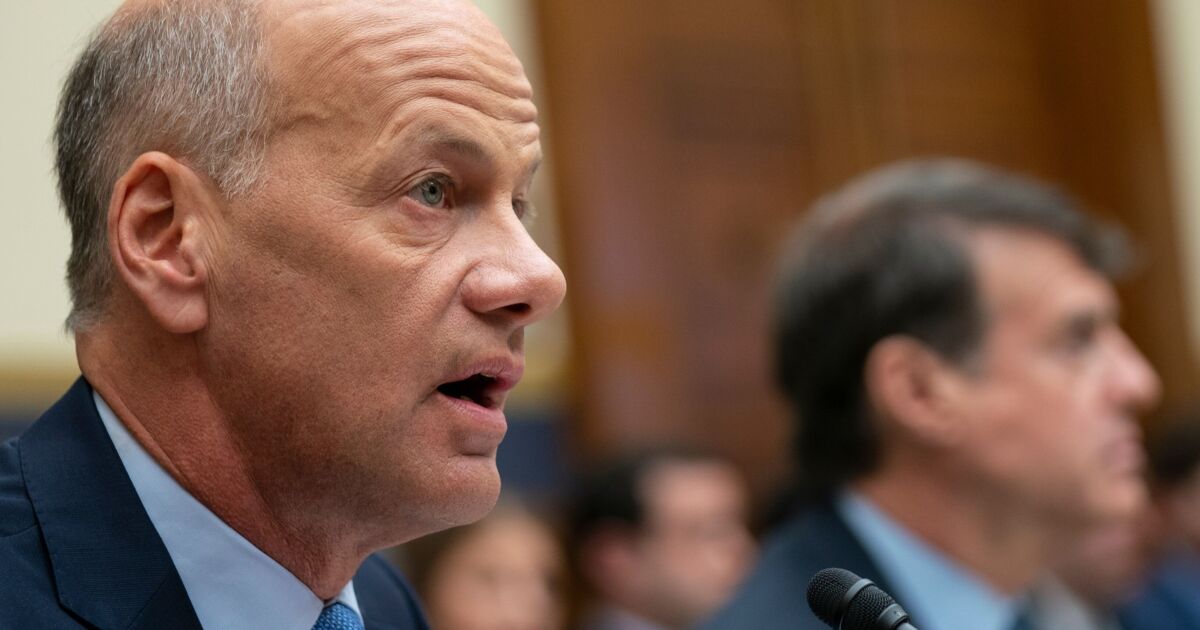
The Federal Reserve Bank of San Francisco considered removing Silicon Valley Bank CEO Greg Becker from its board of directors over a looming ratings downgrade in 2022, but opted not to, citing concerns about sending market signals and betraying supervisory confidentiality.
In a report on the failure of Silicon Valley Bank released Thursday morning, the Fed's Office of the Inspector General noted that Becker's presence on the San Francisco Fed's board created complications for the reserve bank as examiners built a case for taking supervisory action against SVB to compel it to address various risks and deficiencies.
While it was not one of the report's seven official recommendations, the OIG urged reserve banks to establish a policy that would prohibit sitting bank executives from serving on reserve bank boards.
"We believe that the CEO's service on the [Federal Reserve Bank of] San Francisco board of directors created an appearance of a conflict of interest for the system," the report reads. "Given the potential for market-signaling challenges when removing a reserve bank board member, we encourage the Board [of Governors] to consider assessing the current policy."
Becker's presence on the board has been a source of debate since SVB succumbed to a massive run on deposits in March and triggered a short-lived crisis in the banking system. Some in Washington have questioned whether it prevented Fed supervisors from being as tough on the bank as they should have been.
Becker was removed from the reserve bank board in March after SVB failed and fell into Federal Deposit Insurance Corp. receivership.
The Federal Reserve System's 12 regional reserve banks each have three tiers of directors. Class B and C directors are appointed to represent the public in each district; they are nominated by the banks in a given region and the Fed Board of Governors, respectively. Class A directors, meanwhile, are supposed to represent the interests of the banks.
Fed officials have noted that class A directors play no role in shaping oversight policies and they are not supposed to be privy to supervisory information. But politicians and policy advocates have questioned how much of a firewall there is between the various functions of the reserve banks.
"I think it would come as a shock to most Americans to find out that Gregory Becker, the CEO of Silicon Valley Bank, who successfully lobbied for the deregulation of his financial institution was allowed to serve as a director of the same body in charge of regulating his bank: the San Francisco Federal Reserve," Sen. Bernie Sanders, I-Vt., said in a March statement. "It is clear to me and to the American people that the CEOs of the largest banks in America should not be allowed to serve as directors of the main agency we have in this country in charge of regulating those very same financial institutions."
The OIG found no conflicts of interests or other issues related to Becker's service on the board, but it noted that his presence did create issues.
Specifically, the report states that senior officials at the reserve bank had concerns about having the CEO of a bank with falling supervisory ratings on its board. There is no policy in place about this, but at least one official told OIG investigators they were "surprised" Becker remained on the board after SVB was downgraded in August 2022.
Ultimately, the report notes, officials concluded that forcing Becker off the reserve bank's board would tip the market off to SVB's struggles and could therefore divulge confidential supervisory information, which is illegal.
Moving forward, the report suggests banks nominate retired executives to represent their interests to "mitigate the potential for conflict of interest appearance issues."
"Further, we encourage the Board [of Governors] to consider whether standards for service and removal can be established for class A directors currently employed by supervised institutions that appropriately balance all competing interests, including avoiding signaling to the public a bank's declining condition," the report reads.
Unlike the official recommendations from the report, the board of governors did not respond to this call to action.
The OIG compiles material loss reports on any bank failure that results in a loss of $50 million or more to the Deposit Insurance Fund. As of May, the FDIC estimates SVB's failure will cost the DIF more than $16 billion.
According to the report, Fed supervision failed in three key ways. First, the Regional Bank Organization group, or RBO, which supervises banks between $10 billion and $100 billion, did not adapt its oversight practices to keep pace with SVB's rapid growth. Then, the board of governors and San Francisco Fed mishandled the transition of the bank into the Large and Foreign Banking Organization portfolio, or LFBO, which oversees banks with more than $100 billion of assets. And finally, examiners did not pay close enough attention to the way changing interest rates impacted SVB's balance sheet.
The report notes that examiners repeatedly missed opportunities to lower the bank's capital adequacy, asset quality, management, earnings, liquidity and sensitivity to market risk ratings — known collectively as CAMELS ratings. It also says that supervisors should have taken "stronger supervisory action sooner to communicate the urgency of the issues."
It also noted that an acute focus on risk management deficiencies caused supervisors on the LFBO team to overlook the bank's dwindling financial conditions. The report adds that even though examiners identified significant issues at the bank in September 2021, they held off on downgrading the bank for almost a year to "gather sufficient evidence" first.
The findings largely echo the conclusions reached by Fed Vice Chair for Supervision Michael Barr in his post mortem report published in late April.
The OIG report calls for the Fed to review and amend practices by its RBO supervision group to ensure it is more responsive to changing risk profiles in banks and its tailoring regime promotes "timely focus on salient risks." It also directs the Fed to adjust its transition practices when banks move from one supervisory portfolio to another, including around staff. Finally, it calls for examiners, especially in the LFBO group, to put a greater emphasis on existing financial conditions.
The Fed concurred with all of the OIG's findings and noted that it is already in the process of addressing many of the shortcomings outlined. It committed to addressing all of the recommendations by the end of next year.



